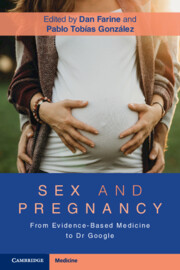Book contents
- Sex and Pregnancy
- Sex and Pregnancy
- Copyright page
- Dedication
- Contents
- Contributors
- Preface
- Section 1 General Issues
- Chapter 1 From Sex for Reproduction to Reproduction without Sex
- Chapter 2 Sex in Pregnancy
- Chapter 3 Physiology of Pregnancy As Related to Sex
- Chapter 4 Does Orgasm Affect Fetal Well-Being?
- Chapter 5 Demographics of Sexual Behavior in Pregnancy
- Chapter 6 Sexual Practices during Pregnancy in Different Cultures
- Chapter 7 What Do Obstetric Guidelines Say?
- Chapter 8 Using the Internet to Educate on Sex and Pregnancy
- Section 2 Specific Issues
- Index
- References
Chapter 4 - Does Orgasm Affect Fetal Well-Being?
from Section 1 - General Issues
Published online by Cambridge University Press: 09 November 2022
- Sex and Pregnancy
- Sex and Pregnancy
- Copyright page
- Dedication
- Contents
- Contributors
- Preface
- Section 1 General Issues
- Chapter 1 From Sex for Reproduction to Reproduction without Sex
- Chapter 2 Sex in Pregnancy
- Chapter 3 Physiology of Pregnancy As Related to Sex
- Chapter 4 Does Orgasm Affect Fetal Well-Being?
- Chapter 5 Demographics of Sexual Behavior in Pregnancy
- Chapter 6 Sexual Practices during Pregnancy in Different Cultures
- Chapter 7 What Do Obstetric Guidelines Say?
- Chapter 8 Using the Internet to Educate on Sex and Pregnancy
- Section 2 Specific Issues
- Index
- References
Summary
The physical and psychological changes a woman undergoes during pregnancy impact various areas of her life, including her sexual life. Sexuality during pregnancy is important, as there is a strong link between sexual satisfaction and overall life satisfaction. Women’s sexual response, classically divided into four stages (excitement/arousal, plateau, orgasm, and resolution), is more complex. Several hormones are involved in sexual arousal, such as oxytocin, β-endorphin, and prolactin. The effect of orgasm during pregnancy has not been well studied and available evidence is lacking. In the absence of evidence of harm, it seems reasonable to conclude that orgasm is safe in pregnancy, at least in low-risk ones.
- Type
- Chapter
- Information
- Sex and PregnancyFrom Evidence-Based Medicine to Dr Google, pp. 23 - 26Publisher: Cambridge University PressPrint publication year: 2022



